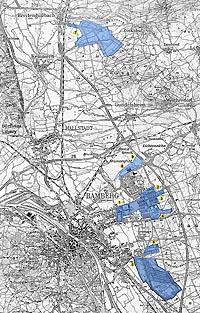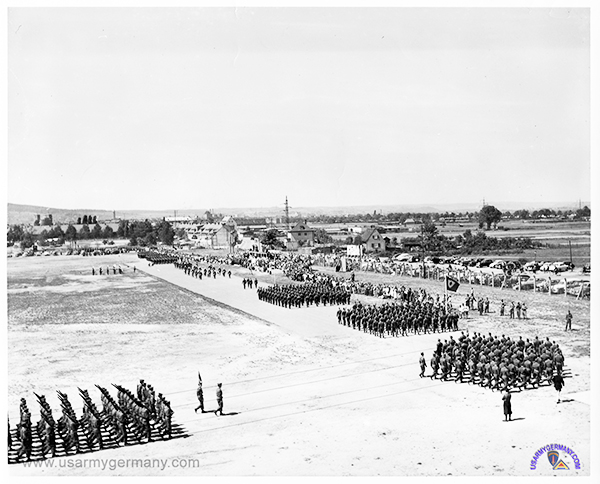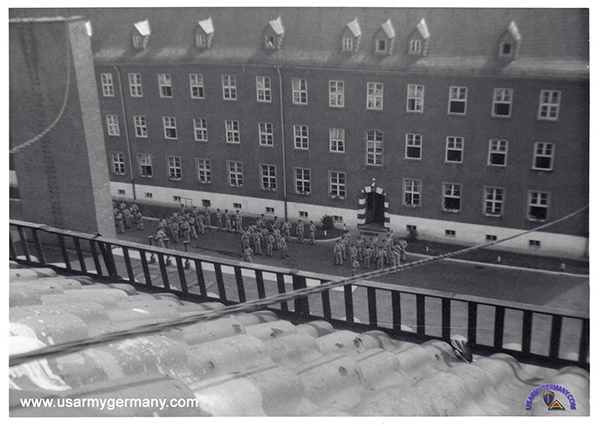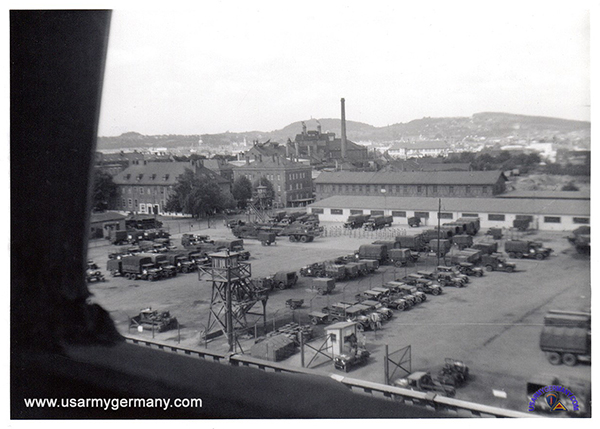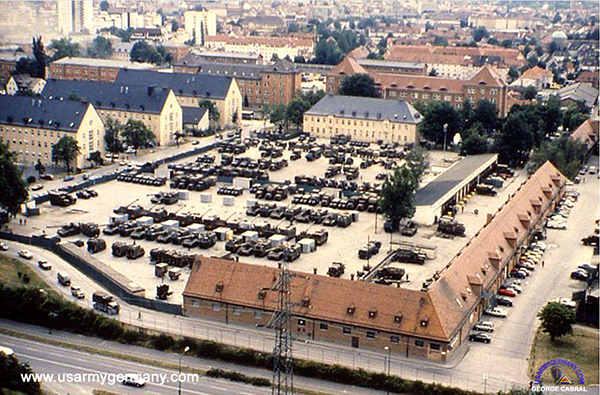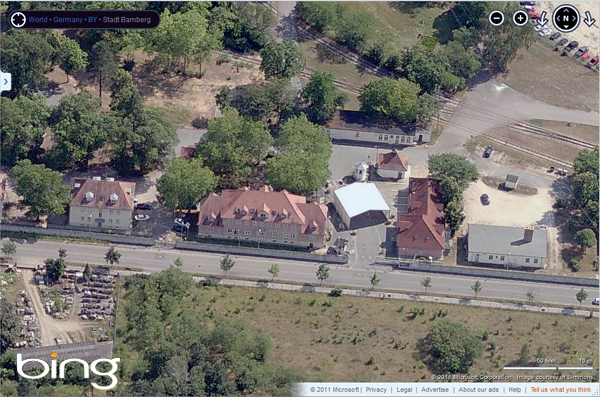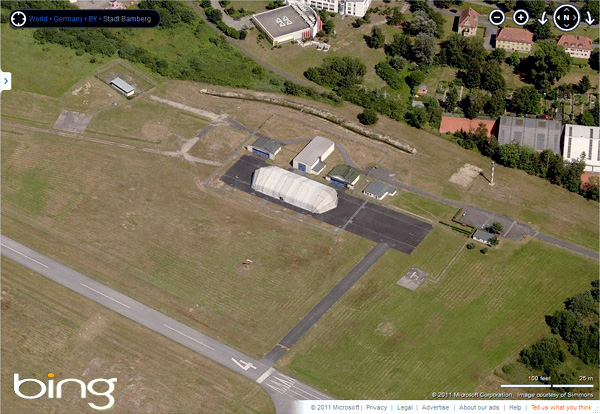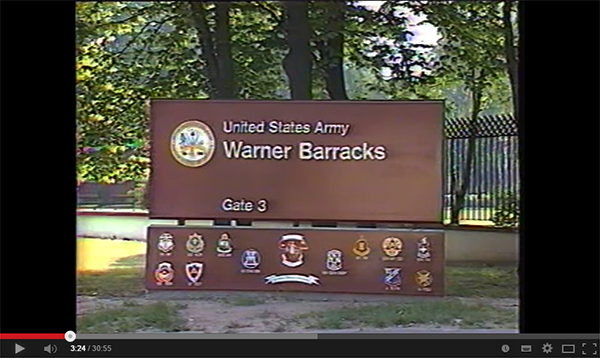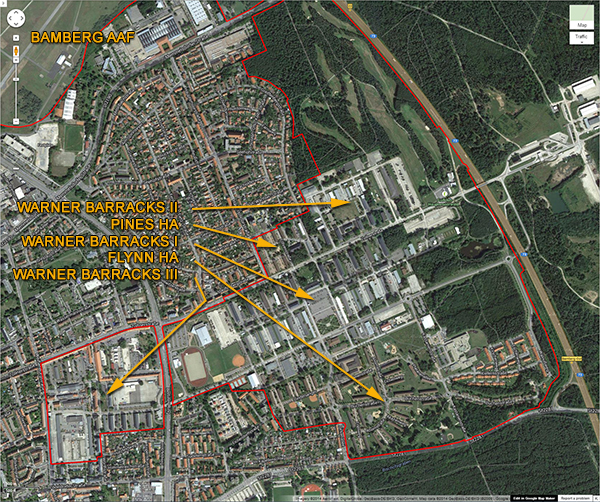Click here to open 'USArmyGermany' frameset
CAMP LEONARD |
| MAPS |
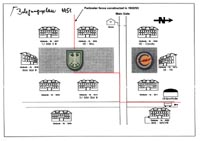 1. Hindenburg Ksn/Harris Barracks, Coburg, 1950-52 (113 KB) |
| 1960s Topographical map of Bamberg and surrounding area. Probably around the late 1960s. Legend: 1. Warner Barracks III 2. Warner Barracks 3. Warner Barracks 4. Dependent Housing Area 5. Muna Kaserne 6. Reese Range 7. Breitengüßbach 8. Bamberg AAF 9. Tactical Defense (ADA) site? Click on the thumbnail to view a larger format of the same map. |
 |
 1. Hqs US Constabulary & Bamberg Telephone Directory, December 1946 |
|
|
 |
|
 1. Warner Barracks, 1950 Click here to supersize |
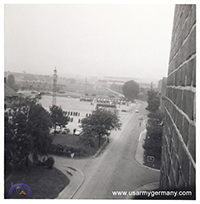 2. Warner Bks III, 1962 |
|
|
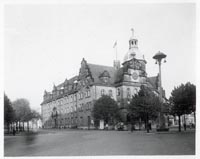 1. Bamberg APO, 1948 |
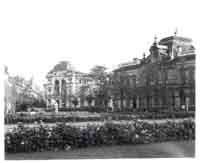 2. Bamberg Officers Club, 1948 |
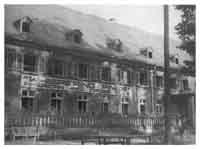 3. Whispering Pines ARC Club, 1948 |
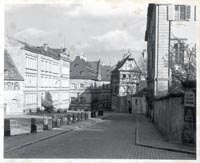 4. Bamberg American Dependents School, 1948 |
|
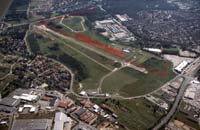 6. Bamberg AAF, 2003 |
||||
|
||||
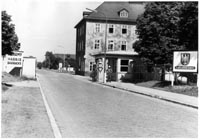 1. Main gate, Harris Bks, 1950s |
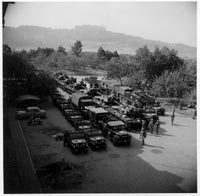 2. Border ops unit |
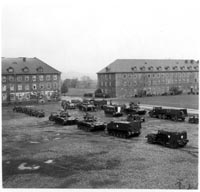 3. Armored vehicles parked on parade field |
||
|
||||
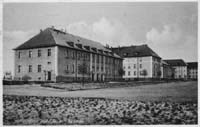 A. Kaserne, Hof |
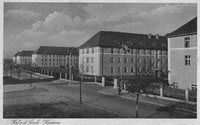 B. Kaserne, Hof |
|||
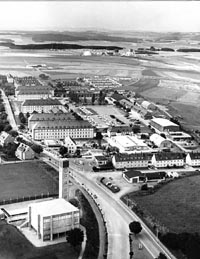 1. Kingsley Bks, 1965 |
|
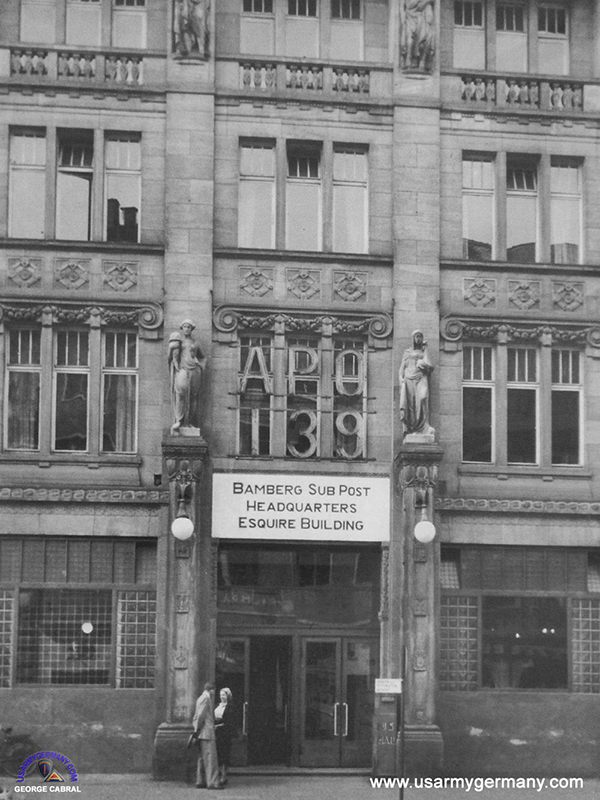
Headquarters building, Bamberg Sub Post (George Cabral)
However, just a few months later, on October 1, the post was discontinued and its area and mission absorbed by the Nürnberg Military Post. Bamberg continued administratively as a subpost under NMP.
In April 1945, at the end of World War II hostilities in the European Theater of Operations, military installations in or near the City of Bamberg, presently known as "Warner Barracks", "Muna", and "Airfield" were selected by the occupying US forces, because they were already existing as complete facilities, established and constructed exclusively for military purposes. The confiscated facilities comprised three different barracks complexes, one ammunition assembly plant and storage area, and an Army aviation facility (Hasty Airfield). The installations were identified by their original German name as:
|
The oldest part of barracks compound is Warner Barracks III, which was started to be constructed at the end of the 19th century to provide military facilities for the Royal Bavarian Light Cavalry. The first building was occupied in 1898. The continued construction efforts, undertaken by the Royal Bavarian Government were completed during World War I, when in 1916 the last building of the pre-World War I and World War I series was occupied.
During World War I, the construction of an ammunition assembly and storage facility outside the City of Bamberg boundaries in the forest area east of Bamberg-Nuremberg road was started. At the end of World War I it comprised approximately 1/3 of the present facility.
At the end of World War I, the collapse of the Royal Regime and the defeat of the German Empire caused a cease in further military construction until 1925/26, when additional buildings were erected for National Guard (Landespolizei) supply, training and logistical purposes.
After the 1935 issued governmental declaration of non-adherence to and voidance of the Versailles treaty, the re-armification of Germany followed with a nation-wide construction program for the erection of appropriate barracks complexes and support facilities.
In Bamberg, the program resulted in the construction of a barracks complex (now named "Warner Barracks I") for a regiment of the 1st Armored Division of the German Forces and another barracks compound (now named "Warner Barracks II") for a field artillery battalion.
"Warner Barracks III" area, additional buildings were erected and the ammunition assembly facility was enlarged to provide adequate ammo storage with appropriate transportation facilities such as roads and rail spurs.
The construction efforts continued until mid-World War II, providing "Warner Barracks III" with additional troop billets and dining facilities, and the establishment of an Army Aviation Hasty Airfield on the northern outskirts of Bamberg.
After World War II, the US Army as occupational forces displayed no or only limited interest in the future planning and development of the occupied facilities until 1950, when the first political steps were undertaken by the German and the US Government to settle the later " Statute of Forces Agreement, "SOFA"), which became the basis of continued stationing of US Forces in Europe, especially in the Federal Republic of Germany (FRG).
A more or less improvised Master Planning resulted first during the years 1950 thru 1955 in the construction of the military family housing area "Pines" area and "Thomas F. Flynn Village", a US dependent school, and the BOQ buildings on until then unimproved US-controlled real estate adjacent to the existing barracks areas. In 1954/55, the new DA approved concept of promotion of life style enhancement within the forces caused the construction of company-size dining facilities to replace the battalion-size messhalls, of a post gymnasium and outdoor recreational facilities. Until 1955, all construction was funded and financed by the FRG.
Many buildings were converted from their original designed purpose to more modern and adequate use for the troops and their families now residing in the new government quarters. Former horse stables were converted to commissary, shopping center, clubs, music & theater center, maintenance shops, and post office. Former inside riding exercise buildings became a snack bar, main retail store and commissary warehouse. Excess maintenance buildings (garages) were designated as post chapel, snack bar/delicatessen shop, QM laundry pick-up points, clothing sales store, one troop billets building was converted to a recreation center with special services club, library, crafts shops, education center. Former inside infantry drill buildings were converted to a movie theater, a gym and an EES service garage.
Within the Ammo Depot area a coal yard, a class III POL storage facility and cold storage facilities were established as was a RR tank loading facility constructed to provide logistical and support activities within the FRG-owned, US-controlled real estate.
The Army Airfield capacity was increased by one wooden hangar, dismantled at the Coburg Army Airfield, hauled to Bamberg and re-erected as third hangar. The original grassy landing strip, taxiways and apron were improved by the installation of PSPs, which later were partly replaced by asphaltic surfaces.
(excerpt from: Handbook of the USMCA Bamberg Directorate of Engineering and Housing, 1984)
Cultural Monuments
In January 1996 the list of the Bavarian Cultural Monuments was updated. There was a supplement in this list concerning the Warner Barracks:
Object: Poedeldorfer Strasse 77, 79, 81, Weissenburgstrasse 2, 4, 6, 8, 10 (building # 7104, 7105, 7106, 7107, 7108, and 7114) and Woerthstrasse 1, 3, 5, 7 (building # 7091, 7090, 7089). Former Lagarde-Kaserne, construction of different partially multiple winged buildings including a four-sided barrack square; main buildings, bricks with sandstone subdivisions, historical value; 1890/92; riding hall, 1890; personnel buildings, minor historical value, 1912, 1913, and 1915.
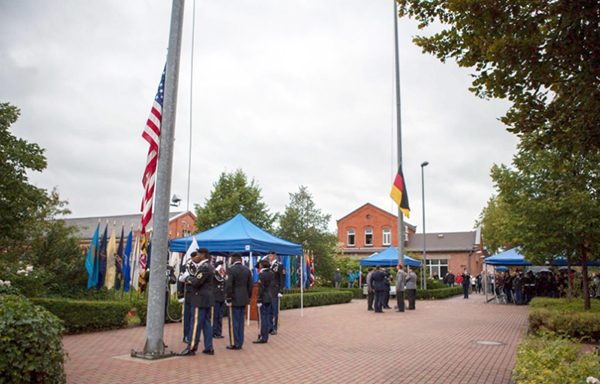
For the last time: US and German color guards lower their respective countries' flags at
Warner Barracks on Sept 12 2014 (Stars and Stripes photo)
|
| WARNER
BARRACKS, Bamberg Warner Barracks, which has the appearance of two large kasernes connected by a bridge, is actually the sum of many smaller garrisons that were joined together over time. Lagarde Kaserne dates back to the 1890s and was occupied by a cavalry unit. The unit had its own riding school on post, in the area that is now occupied by the present-day PX, commissary, engineer billets and bowling center. Later, a new Cavalry Kaserne was built in the area now occupied by the Pines Housing Area and the Officers Club. This kaserne later was named Panzer Kaserne. In 1933, there was an increase of forces in Bamberg, and by 1936, the shape and size of twoday's Warner Barracks was fully realized with the construction of the Artillerie Kaserne, located in the vicinity of 3rd Brigade headquarters and the surrounding buildings. |
The Bamberg Ammunition Plant (“Muna”) was originally built in 1917 for the production of ammunition for World War I. During World War II, it was reactivated and expanded, with 67 buildings, mostly ammunition bunkers, in 1945. Each of the bunkers had a storage capacity for 60 tons of explosives.
In April 1945, only 10 days after the U.S. forces entered Bamberg, the 2nd Platoon, and 33rd Chemical Decontamination Company captured the ammunition plant, and placed guards at the facility. The depot was cleared, but it was decided that the facility should remain under U.S. command. An additional chemical shell dump was closed in Bayreuth on 5 May by the 61st Chemical Depot Company. Chemical supplies from this depot were transported to Bamberg.
During the first year of occupation, a total of 12,000 tons of ammunition was removed from the Bamberg Ammunition Depot. 10,000 tons of this ammunition was shipped to U.S. depots, while 2,000 tons were destroyed.
After all German ammunition was removed from the Muna, the U.S. forces used the facilities for ammunition storage. Personnel at the depot provided technical and operational supervision for the Ordnance Ammunition Companies that were stationed in the installation and in the sub-depot Breitenguessbach after 1947. The sub-depot at Breitenguessbach, which was utilized for the storage of engineered high explosives and mines, was closed 15 March 1951. The Oberdachstetten Explosives Depot also fell under Bamberg’s operational control; this was closed in 1947 after the disposal of all the captured enemy ammunition.
During the Cold War, various US Army Units were stationed at Warner Barracks, including: The 3rd Infantry Division; the 4th Armored Division; 7th Armored Cavalry; 5 Missile Battalion, 39th Artillery (LaCross Missile); 2nd Battalion, 35th Artillery (155mm towed guns), 1st Battalion, 75th Artillery (8" Self-Propelled Artillery), a 175mm Self-Propelled Artillery unit, and various support units. Most of the Artillery units were posted on the lower Kasserne, on Poodledorfer Strasse (which no longer exists, it is now a civilian housing area).
The building housing the 5th Missile Battalion, 39th Artillery later became the headquarters of the 35th Artillery Group.
During the Cuban Missile Crisis in October, 1962, the 5th Missile Battalion had 3 missiles, armed with nuclear warheads, ready to fire on 5 minutes notice. This unit had missiles ready to fire for 21 straight days, before we received the order to "stand-down". Three soldiers from this battalion formed a singing group, called "The Phoenicians", which performed in a large variety of settings in Bavaria.
Two soldiers from the 1st Battalion, 75th Artillery gave up their own leave time to build a major extension to the Chapel located at the Kloster Maria Frieden (later the Abtei Maria Frieden) in Kirschletten. This was built in April and May 1964. Those two lived in the wash house of the convent, working from dawn to dusk, 6 days a week, to get this project built. Other soldiers would come out on Saturdays, to assist with the building. The 82nd Engineers lent some construction equipment (jackhammers and a cement mixer). In addition to doing the construction work, the soldiers involved also collected money from most of the units in Bamberg to help pay for this project. Eventually, because of the good publicity that this project gained for the Army, these soldiers had their leave time restored to them, and the US Army gave them "Administrative Leave" for the entire two months it took to complete the addition. They were also brought back from field exercises, when the Bishop of Bamberg dedicated this Chapel.
That addition is still standing, but is used as a storeroom today.
Related Links: Hof Reunion Association, 1948-1975 Camp Harris, Coburg - a great page with additional photos and history on the Eaglehorse.org (2nd Sq, 11th ACR) web site |
